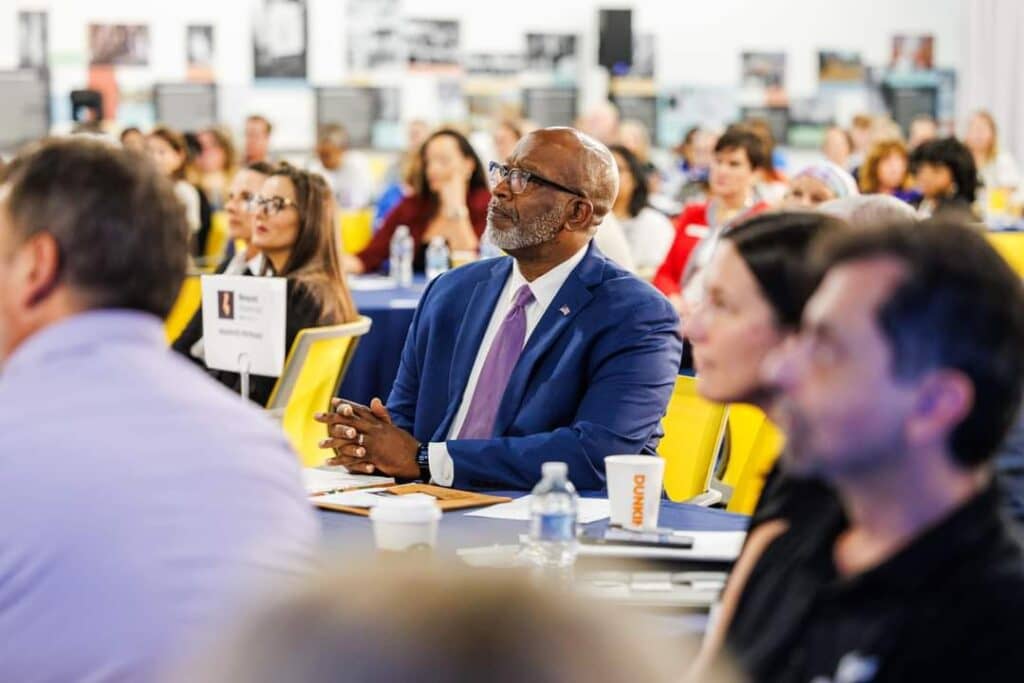Impact
Expansive assessment highlights nonprofit challenges, successes

Hundreds of local nonprofit leaders and stakeholders recently engaged in a data-driven dialogue on the current state of Pinellas County charitable organizations.
The Foundation for a Healthy St. Petersburg (FHSP) hosted the State of Nonprofits event Oct. 4 at its Center for Health Equity. Attendees heard the results of a 108-page assessment conducted by the Pinellas Community Foundation (PCF), the St. Petersburg Foundation (SPF) and experts from the University of South Florida’s Muma College of Business.
Mayor Ken Welch said the county’s 26,658 nonprofit employees didn’t choose the career for money or prestige.
“You’re here because you have what I call the DNA of community service and servant leadership,” Welch added. “And I want to commend you for the work that you do every day to provide support for those in our community who need it the most.”
He noted that the complexities of running a nonprofit now mirror the for-profit sector. Welch believes the assessment’s data will help inform decisions and that collaboration can propel community impact.
He summarized his thoughts with a quote from cultural anthropologist Margaret Mead: “Never doubt that a small group of thoughtful, committed individuals can change the world. In fact, it is the only thing that ever has.”
“I know she was talking about the same kind of folks we have in this room today,” Welch said.

Mayor Ken Welch listens to the 2023 Pinellas County Nonprofit Assessment’s results. Photo: City of St. Petersburg.
The 2023 assessment builds upon the 2018 Pinellas County Nonprofit Scan and Survey commissioned by FHSP. It found that the average nonprofit employee earns around $60,000 annually, less than the statewide $63,000 average for all industries.
Joe Hamilton, cofounder of SPF, noted organizations often compete for the same resources and talent. However, he said a commitment to improving the community can overcome those obstacles.
“Because … what we have in this group is really an abundance of resources in the way that we can collaborate with each other,” Hamilton said. “In the ways we can share services and teach each other best practices – which ultimately helps us free up our resources.”
Pinellas nonprofits fill a vital role, as 36% of county households live paycheck to paycheck. “One sort of bump in the road away from disaster,” Hamilton said.
Kanika Tomalin, CEO of FHSP, said data is critical to the organization’s work as it highlights organizational needs and potentially transformational partnerships. She said the survey would help FHSP discern where investments can provide the most impact.
Phillip Trocchia, director of USF St. Petersburg’s Customer Experience Lab, said 161 nonprofit leaders responded to the 78-question assessment. He said its 16% response rate was “actually quite good,” compared to 10% to 12% for business surveys.
Duggan Cooley, CEO of PCF, said about 75% of respondents measure and mirror their surrounding demographics. However, he said smaller organizations found that challenging.
“That might be an issue that we want to delve into more …,” Cooley said.
He noted that 94% of nonprofit leaders thought their employees strongly aligned with the organization’s mission, and 90% believed their staff and board share a strong value statement. “This is exactly what we want to see in this section,” Cooley added.
Here are some other key aspects of the assessment:
- Over 80% of respondents said their boards were “definitely” or “mostly” helpful with fundraising.
- Nearly 70% felt optimistic about their ability to grow the organization.
- The top two funding sources reported were government and private donors.
- Only half the organizations met fundraising goals over the past three years.
- The rising cost of Tampa Bay real estate “is a problem across the board for nonprofits.”
- The two most frequently cited challenges were the ability to pay competitive wages and keep pace with increasing service demands.
- Some nonprofit funders require burdensome reporting, mitigating grant benefits.
Here are some recommendations based on key findings:
- Create data-informed presentations for individual donors, businesses and public officials that outline rising costs and increase service demands.
- Work collaboratively to cultivate, attract and reward workers who prioritize a work-life balance and sense of mission.
- Collectively pool resources to leverage media and engage potential donors.
- Foster a culture of giving by combining ideas for a message, strategy or campaign that will capitalize on one of the largest wealth transfers in U.S. history occurring over the next several years.
“I think that what we hope will come out of this is us as a group, as a sector, deciding what our priorities are,” said Karen Chassin, SPF executive director emeritus. “Advocacy can’t happen without data collection like this – but that’s only the first step.
“I think there’s room to work in concert with our funders to address this issue of competition for scarce resources and work to do within ourselves.”
To read the full assessment, visit the website here.







